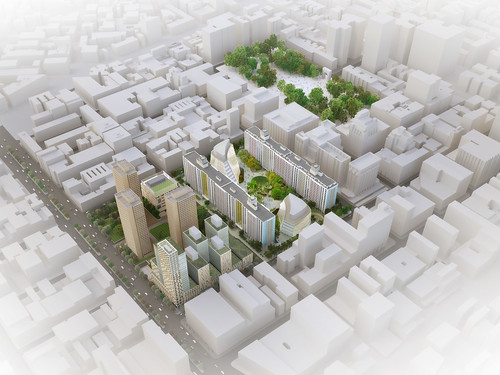
(Courtesy of NYU)
To the surprise of no one, NYU has announced that it will appeal a State Supreme Court judge’s ruling that it must get the state’s blessing to build on parts of two superblocks in Greenwich Village.
Justice Donna M. Mills ruled Tuesday that three strips within the construction zone constituted public parkland, meaning NYU would have to get the State Legislature’s approval to build on them. In a message to the NYU community circulated this afternoon, the university’s general counsel, Bonnie Brier, disputes what plaintiffs have said, that NYU will now have to get the city’s approval all over again if it wants to start building at all.
“The judge permits us to move ahead, provided that we do not ‘substantially interfere’ with the three strips she designated as parkland; and none of those strips is near the Coles site, where the University’s plan proposes to build first,” Brier writes. Meaning a “zipper” building could rise as tall as 26 stories there.
An attorney representing the community groups that sued NYU has said he’ll go back to the judge if NYU attempts to build despite this week’s decision.
Here’s Brier’s complete memorandum, which reminds us that construction will depend on a final report from the University Space Priorities Working Group, expected in the coming weeks.
On Tuesday, Justice Donna Mills issued her ruling in the lawsuit seeking to overturn the City approvals we received to build, over the coming decades, new University facilities on the Silver Towers and Washington Square Village blocks. I write to you today to report on her decision.
The petitioners (various community groups and individuals, including Faculty Against the Sexton Plan) made six claims in their lawsuit (against respondents city and state officials, agencies and bodies that approved our project, and against NYU). The judge dismissed five of the claims, affirming the validity of the City’s approval of our plans.
The petitioners sixth claim involves five strips of City-owned land located on LaGuardia Place and Mercer Street and whether they should be deemed parkland, which carries greater restrictions. All parties agree that the disputed strips are mapped as streets and not as parkland. The key issue is whether the strips constitute parkland “by implication.”
The judge ruled that two of the strips are not “implied parkland,” including the dog run at Mercer and Houston Streets by the Coles gym, thus assuring there are not impediments to moving forward with the new academic facility on the site where Coles now stands.
The judge further ruled that three of the strips are “implied parkland”: the playground along Mercer Street between Bleecker and West 3rd Streets; the strip along La Guardia Place between Bleecker and West 3rd Streets; and the community garden on La Guardia Place south of Bleecker Street. While the City and NYU disagree with the judge’s designation, the court’s ruling simply means that actually building on those three strips (which our approved plans did not include), or using them for prolonged construction staging (which was contemplated; but we are permitted to proceed if we develop alternate staging), would require a successful appeal or approval of the State legislature. We are appealing and working closely with the City.
President Sexton has made clear that construction will await – and be guided by – the final report of the University Space Priorities Working Group (composed principally of faculty, with student and faculty representation as well). The Working Group’s final report is expected in the coming weeks; you can read their preliminary report here. We are all grateful to the members of the Working Group for their extraordinary commitment of time, thoroughness, and transparency.
Finally, it is not correct – as counsel for the petitioners has claimed – that the opinion requires us to restart the approval processes. The judge permits us to move ahead, provided that we do not “substantially interfere” with the three strips she designated as parkland; and none of those strips is near the Coles site, where the University’s plan proposes to build first.





